Modernism in the Catholic Church
| Part of a series on the |
| History of Christian theology |
|---|
 |
|
|
Modernism in the Catholic Church describes attempts to reconcile Catholicism with modern culture,[1] specifically an understanding of the Bible and Catholic tradition in light of the historical-critical method and new philosophical and political developments of the late 19th and early 20th centuries.
The term modernism—generally used by critics of rather than adherents to positions associated with it—came to prominence in
Writing in the
The controversy on modernism was prominent in French and British intellectual circles and, to a lesser extent, in Italy, but, in one way or another, concerned most of Europe and North America.[5] Pope Pius X saw modernism as a universal threat which required a global reaction.[6]
Dimensions of the controversy over modernism
Although the so-called modernists did not form a uniform movement, they responded to a common grouping of religious problems which transcended Catholicism alone around 1900: first of all the problem of historicism, which seemed to render all historical forms of faith and tradition relative; secondly, through the reception of modern philosophers like Immanuel Kant, Maurice Blondel, and Henri Bergson, the neo-scholastic philosophical and theological framework set up by Pope Leo XIII had become fragile. The assertion that objective truth is received subjectively is fundamental for the entire controversy.[7] This focus on the religious subject engendered a renewed interest in mysticism, sanctity[8] and religious experience in general.[9] The aversion against a religious "extrinsicism" also led to a new hermeneutics for doctrinal definitions which were seen as secondary formulations of an antecedent (immanent) religious experience (George Tyrrell; cfr. also the Christian personalism of Lucien Laberthonnière).[10]
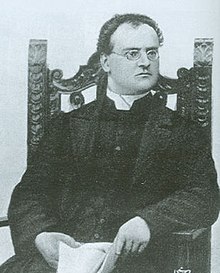
The controversy was not restricted to the field of philosophy and theology. On the level of politics, Christian Democrats like the layman Marc Sangnier in France and the priest Romolo Murri in Italy, but also the left wing of the Centre Party and the Christian Unions in Germany, opted for a political agenda which was no more completely controlled by the hierarchy. Pope Pius X reacted by excommunicating Murri in 1909, by dissolving Sangnier's Sillon movement in 1910, and by issuing the encyclical Singulari quadam in 1912 which clearly favoured the German Catholic workers' associations over and against the Christian Unions.[11] Furthermore, antimodernists like Albert Maria Weiss OP,[12] and the Swiss Caspar Decurtins,[13] which were both favoured by Pius X, would even find "literary modernism" on the field of the Catholic belles-lettres which did not meet their standards of orthodoxy.[14]
In the eyes of the antimodernist reaction, the "modernists" were a uniform and secret sect within the church. In a historical perspective, one can discern networks of personal contacts between "modernists", especially around Friedrich von Hügel and Paul Sabatier. On the other hand, there was a great bandwidth of opinions within the "movement", from people ending up in rationalism (e.g. Marcel Hébert,[15] Albert Houtin, Salvatore Minocchi, and Joseph Turmel)[16] to a mild religious reformism, even including neo-scholastic theologians like Romolo Murri.[17] This perception of a broad movement from left to right was already shaped by the protagonists themselves.[18][19]
Terminology
The term
In 1881, the Belgian economist
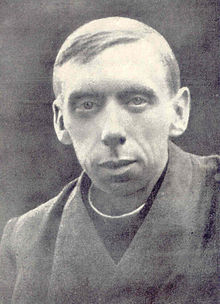
The connection between 'Liberal Catholicism' and 'modernism' has been subject to controversial discussion. In 1979, Thomas Michael Loome stressed the continuity between the two and talked of a "vertical dimension" of the modernist controversy.
History of the modernist controversy
Although the so-called "Modernist Crisis"[5] is usually dated between 1893 (the publication date of Pope Leo XIII's encyclical Providentissimus Deus) and 1914 (the death of Pope Pius X),[27][28] the controversy had, and continues to have, both a pre-history and a post-history.
Pre-history: 19th century intellectual ferment
With notable exceptions like Richard Simon or the Bollandists, Catholic studies in the 17th, 18th and 19th centuries had tended to avoid the use of critical methodology because of its rationalist tendencies. Frequent political revolutions, the bitter opposition of "liberalism" to the Church and the expulsion of religious orders from France and Germany had made the church understandably suspicious of the new intellectual currents.[29]
In his encyclical of 1829 Traditi humilitati, Pope Pius VIII had admonished those who "publish the Bible with new interpretations contrary to the Church's laws" and "skillfully distort the meaning by their own interpretation", in order to "ensure that the reader imbibes their lethal poison instead of the saving water of salvation".[30]
In similar vein, in 1832 his successor Pope Gregory XVI condemned in his encyclical Mirari vos "shameless science" (scientia impudens) deploring that the "divine authority of the Church is [...] subjected to human reason".[31] Gregory also warned Catholics not to read translations of the Bible published by non-Catholic biblical societies, accusing them in his encyclical Inter praecipuas (1844) of "scorning divine tradition preserved by the Catholic Church in the teaching of the Fathers" and of "repudiating the very authority of the Church".[32]
Anti-liberalism and hostility towards modernity continued with the new Pope Pius IX: a few months after his election in 1846, Pius promulgated the encyclical Qui pluribus, exhorting all Catholic prelates to be on guard against the dangers posed by rationalism, pantheism, socialism, communism and other popular philosophies.[33]
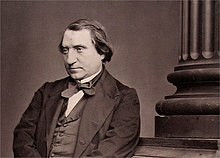
In 1863, Ernest Renan published Vie de Jésus (Life of Jesus). Renan had trained for the priesthood before choosing a secular career as a philologist and historian. His book described Jesus as un homme incomparable – a man, no doubt extraordinary, but only a man. The book was very popular, but cost him his chair of Hebrew at the Collège de France. Among Renan's most controversial ideas was that "a miracle does not count as a historical event; people believing in a miracle does." Renan's Jesus is a man of simple piety and almost unimaginable charisma whose main historical significance was his legion of followers.[34]
In the same year 1863, the Church historian
On 8 December 1864 Pope Pius IX issued the encyclical Quanta cura, decrying what he considered significant errors afflicting the modern age. It condemned certain propositions such as: "the people's will, manifested by what is called public opinion [...] constitutes a supreme law, free from all divine and human control"; on civil law alone depend all rights of parents over their children, and especially that of providing for education; and that religious orders have no legitimate reason for being permitted.[39] Some of these condemnations were aimed at anticlerical governments in various European countries, which were in the process of secularizing education and taking over Catholic schools, as well as suppressing religious orders and confiscating their property.[40] Attached to the encyclical was a Syllabus Errorum, which had been condemned in previous papal documents, requiring recourse to the original statements to be understood. The Syllabus reacted not only to modern atheism, materialism, and agnosticism, but also to Liberal Catholicism and the new critical study of the Bible. It was also a direct reaction to Döllinger's speech in Munich and Montalembert's speeches in Malines.[41] Among the propositions condemned in the Syllabus were:
- "7. The prophecies and miracles set forth and recorded in the Sacred Scriptures are the fiction of poets, and the mysteries of the Christian faith the result of philosophical investigations. In the books of the Old and the New Testament there are contained mythical inventions, and Jesus Christ is Himself a myth."
- "13. The method and principles by which the old scholastic doctors cultivated theology are no longer suitable to the demands of our times and to the progress of the sciences." – Letter to the Archbishop of Munich, Tuas libenter, December 21, 1863.
- "15. Every man is free to embrace and profess the Religion he shall believe true, guided by the light of reason." – Apostolic Letter, Multiplices inter, 10 June 1851. Allocution Maxima quidem, 9 June 1862.
The First Vatican Council was held from December 1869 to October 1870. The council provoked a degree of controversy even before it met. In anticipation that the subject of papal infallibility would be discussed, many bishops, especially in France and Germany, expressed the opinion that the time was "inopportune". Ignaz von Döllinger led a movement in Germany hostile to the definition of infallibility. In Döllinger's view, there was no foundation for this definition in Catholic tradition.[42] After the definition, Döllinger was excommunicated by the Archbishop of Munich Gregor von Scherr in 1871. Montalembert died before the end of the Council.
The dogmatic Constitution on the Catholic Faith, Dei Filius, tried to steer a middle way between rationalism and fideism. It presented a concept of revelation which highlighted the aspect of divine instruction by revelation.[43] The dogmatic Constitution Pastor Aeternus addressed the primacy of the pope and rejected the idea that decrees issued by the pope for the guidance of the church are not valid unless confirmed by the secular power. It also declared the infallibility of the pope when speaking "ex cathedra" on matters of faith and morals. Other matters were deferred when the Italian infantry entered Rome and the council was prorogued.[44] The Council remained formally open until 1960, when it was officially closed by Pope John XXIII, in order to convene the Second Vatican Council.[45]
The First Vatican Council's decisions were so controversial that they even caused a schism of some German, Swiss, Austrian and Dutch liberal Catholics, who broke away from the Vatican and merged with the Jansenists (who had maintained a somewhat precarious hierarchy in the Netherlands) into the Old Catholic Church, which still exists to this day.[46]
The beginning of the modernist controversy under Leo XIII
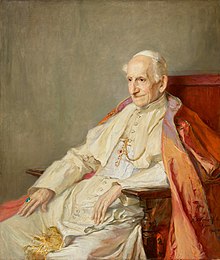
Pope Leo XIII, Pius IX's successor, wanted to advance what he understood as the true Christian science in every way: he worked for a revival of Thomism as Christian philosophy, he encouraged the study of history and archaeology, and in 1881 he opened up the Vatican Archives for researchers.[47] In 1887 he encouraged the study of the natural sciences, and in 1891 opened a new Vatican Observatory.[48] Leo's response to the rationalist trend to undermine the authority of sacred scripture, was for the church to have its own trained experts. In 1893, with Providentissimus Deus, Pope Leo gave the first formal authorization for the use of critical methods in biblical scholarship.[49] "Hence it is most proper that Professors of Sacred Scripture and theologians should master those tongues in which the sacred Books were originally written,[50] and have a knowledge of natural science.[51] He recommended that the student of scripture be first given a sound grounding in the interpretations of the Fathers such as Tertullian, Cyprian, Hilary, Ambrose, Leo the Great, Gregory the Great, Augustine and Jerome,[52] and understand what they interpreted literally, and what allegorically; and note what they lay down as belonging to faith and what is opinion.[53]
Although Providentissimus Deus tried to encourage Catholic biblical studies, it also created problems. In the encyclical, Leo XIII excluded the possibility of restricting the inspiration and inerrancy of the bible to matters of faith and morals. Thus, he interfered in the lively discussion about biblical inspiration in France, where Maurice d'Hulst, the founder of the Institut Catholique de Paris, had opted for a more open solution in his article on La question biblique.[54] Not only exegetes of this "école large" were now in trouble, but also the prominent French theologian Alfred Loisy who worked for a thoroughly historical understanding of the Bible,[55] in order to open up spaces for theological reform.[56] The Roman Congregation of the Index began to prepare a censuring of Loisy's main works, but until the death of Leo XIII in 1903 no decision was taken, as there was also considerable resistance within the Roman Curia against a premature judgment on matters of biblical interpretation.[57]
On the whole, the official Catholic attitude to the study of Scripture at the turn of the 20th century was one of cautious advance, and at the same time of a growing appreciation of what had promise for the future.[58] In 1902, Pope Leo XIII instituted the Pontifical Biblical Commission, which was to adapt Catholic Biblical studies to modern scholarship and to protect Scripture against attacks.[59]
Marie-Joseph Lagrange
In 1890 the École Biblique, the first Catholic school specifically dedicated to the critical study of the bible, was established in Jerusalem by Dominican Marie-Joseph Lagrange. In 1892 Pope Leo XIII gave his official approval. While many of Lagrange's contemporaries criticized the new scientific and critical approach to the Bible, he made use of it. Lagrange founded the Revue Biblique, and his first articles drew sharp criticism, but Pope Leo was not inclined to discourage new ideas.[60] As long as Pope Leo lived, Lagrange's work quietly progressed, but after Leo's death, an ultra-conservative reaction set in.[60] The historical-critical method was considered suspect by the Vatican. Père Lagrange, like other scholars involved in the 19th-century renaissance of biblical studies, was suspected of being a modernist.[61] In 1912 Lagrange was given an order for the Revue Biblique to cease publication and to return to France. The École itself was closed for a year, and then Lagrange was sent back to Jerusalem to continue his work.
Duchesne and Loisy
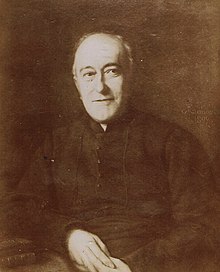
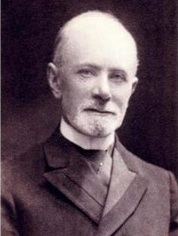
The climax of the controversy under Pius X
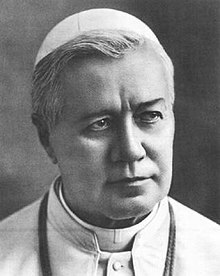
Therefore, in the summer of 1907, another document was prepared in a small circle around the pope, and already in September 1907 Pius X promulgated the encyclical
Pius frequently condemned the movement, and was deeply concerned that its adherents could go on believing themselves strict Catholics while understanding dogma in a markedly untraditional sense (a consequence of the notion of evolution of dogma). Therefore, in 1910, he introduced an anti-modernist oath to be taken by all Catholic priests,[74] while he shut down "the only notable American Catholic magazine", the Ecclesiastical Review "precisely when it was needed to challenge the increasing influence of John Dewey's pragmatism."[75]
To ensure enforcement of these decisions, Monsignor Umberto Benigni organized, through his personal contacts with theologians and laymen in various European countries, a secret network of informants who would report to him those thought to be teaching condemned doctrine or engaging in political activities (like Christian Democratic Parties, Christian Unions) which were also deemed to be "modernist" because they were not controlled by the Catholic hierarchy. This group was called the Sodalitium Pianum, i.e. Fellowship of Pius (V), the code name was La Sapinière.[76] Its frequently overzealous and clandestine methods often hindered rather than helped the Church in its combat with modernism.[77][78] Benigni also published the journal La Corrispondenza Romana/Correspondance de Rome, which initiated press campaigns against practical and social modernism throughout Europe.[79] Benigni fell out with Cardinal Secretary of State Rafael Merry del Val in 1911. The Sodalitium was eventually dissolved in 1921. Recent research has stressed the antisemitic character of Benigni's antimodernism.[80]
In America
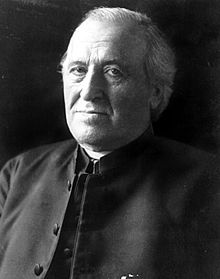
With his slogan "Church and Age unite!",[81] Archbishop John Ireland of Saint Paul, Minnesota, became the hero of reformers in France (Félix Klein), Italy[82] and Germany (Herman Schell) in the 1890s. The modernist controversy in the United States was thus initially dominated by the conflict on "Americanism", which after Pascendi was also presented as a "forerunner" of modernism in Catholic heresiology.[83] "Americanism" was perceived as an influence of classical liberalism in the Catholic Church in the United States, particularly regarding the concept of separation of Church and State. Such tendencies alarmed Pope Leo XIII, who condemned them, at the urging of Archbishop Ireland's old opponent from Minnesota Archbishop John Joseph Frederick Otto Zardetti, in the apostolic letter Testem benevolentiae nostrae (1899).[84][85] Archbishop Ireland had to be extremely careful to avoid condemnation for his views.[86]
Following the issuing of Pascendi, the antimodernist measures were especially felt in the Archdiocese of New York: The New York Review was a journal produced by Saint Joseph's Seminary. It printed papers by leading Catholic Biblical experts who were part of the newly emerging schools of Biblical criticism, which raised eyebrows in Rome. Around 1908, the Review was discontinued, ostensibly for financial reasons, although there is strong evidence that it was suppressed for modernist tendencies.[87][88] Despite his support for modernization, Archbishop Ireland actively campaigned against modernism following the Pascendi encyclical: this apparently inconsistent behavior stemmed from Ireland's concept of a "golden mean" between "ultraconservatism", rendering the Church irrelevant, and "ultraliberalism," discarding the Church's message.[86]
Post-history in the 20th and 21st centuries
After the pontificate of Pius X, there was a gradual abatement of attacks against modernists. The new Pope Benedict XV, who was elected to succeed Pius X in 1914, once again condemned modernism in his encyclical Ad beatissimi Apostolorum, but also urged Catholics to cease condemning fellow believers.[89] Nevertheless, theological antimodernism continued to influence the climate within the church.[90] The Holy Office, until 1930 under the guidance of Cardinal Rafael Merry del Val, continued to censure modernist theologians and rationalist exegesis was once again condemned by the Pontiff in his encyclical Spiritus Paraclitus.[91]
In the 1930s, Loisy's opera omnia were placed on the
Between World War I and the Second Vatican Council,

At the beginning of the 1930s, Congar read the Mémoires of Loisy and realised that modernism had addressed problems in theology which were still not resolved by scholastic theology. Chenu and Congar, two protagonists of the Nouvelle théologie,[98] began to prepare a dossier on this topic. In 1946, Congar wrote to Chenu that scholastic theology had already begun to "liquidate" itself on a daily basis and that the Jesuits were among the fiercest "liquidators".[99] Congar's Chrétiens désunis was also suspected of modernism because its methodology derived more from religious experience than from syllogistic analysis.[100][101]
A first relaxation of the strict anti-modernist measures imposed by Pius X came in 1943: on that year,
Despite his cautious openings on the issue of biblical criticism, Pius XII was suspicious of the new theological trends, which he feared could cause a modernist revival: in 1950, he published the encyclical Humani generis, in which he condemned "certain new intellectual currents" in the Church, accusing them of relativism and attacking them for reformulating dogmas in a way that was not consistent with Church tradition and for following biblical hermeneutics that deviated from the teachings of Providentissimus Deus and Divino afflante Spiritu.[104] The encyclical did not mention any particular theologian but was widely interpreted as a condemnation of the Nouvelle théologie and was followed by an anti-modernist purge in Le Saulchoir and Fourvière.[105]
Following the election of
Following the Council, the more conservative supporters of Nouvelle théologie had important careers in the Church: Hans Urs von Balthasar, Jean Daniélou, Yves Congar and Henri de Lubac were made cardinals by Pope John Paul II, while Joseph Ratzinger was elected as Pope Benedict XVI in 2005. The same could not be said for the more liberal members, who were gradually marginalised due to their extreme views: Hans Küng was stripped from his theological license by the Congregation for the Doctrine of the Faith in 1979 for questioning papal infallibility, while Edward Schillebeeckx was repeatedly condemned by the Congregation and even by Pope Paul VI himself (encyclical Mysterium fidei) due to his heterodox views about Christology and the eucharist.
Reference to modernism continues to be frequent among conservative and traditionalist Catholics.[108][109][110]
Notable persons involved in the Modernist controversy
- John Ireland (1838–1918), Archbishop of Saint Paul. Considered one of the leaders of Americanism, he later turned against modernism.
- Louis Duchesne (1843–1922), priest and philologist, one of his books was placed on the Index Librorum Prohibitorum
- Alfred Loisy (1857–1940), priest and theologian, excommunicated for his views in 1908 and his opera omnia was placed on the Index. Later became an agnostic and a secular scholar at the Collège de France.
- Society of Jesusin 1906 for his views and excommunicated in 1908
- Maude Petre (1863–1942), English nun, close friend of Tyrrell, and a participant in the modernist movement as well as one of its first historians and critics
- Ernesto Buonaiuti (1881–1946), who as a scholar of the history of Christianity and of religious philosophy, was a leader in the Italian modernist movement and was excommunicated in 1925[111]
- Pierre Batiffol (1861–1929), historian of dogma
- Friedrich von Hügel (1852–1925), philosopher of religion
- Wilfrid Ward (1856–1916), English essayist and biographer
- Henri Bremond (1865–1933), French literary scholar, sometime Jesuit, and Catholic philosopher[112]
- Joseph Schnitzer (1859–1939), historian of dogma in Munich[113]
- Giovanni Semeria (1867–1931), Barnabite priest, preacher
- Carl Muth (1867–1944), editor of the cultural and religious journal Hochland
- Herman Schell (1850–1906), German theologian
- Franz Xaver Kraus (1840–1901), church historian, "Liberal Catholic"
In popular culture
- Passionist priest who was trying to be the chaplain to the show business community in Dublin.
- In the episode "The Bishop's Gambit" of the British TV series Anglican clergyman.[115]
See also
- Americanism (heresy)
- Biblical criticism
- Integrism
- Liberal Catholicism
- Désiré-Joseph Mercier
- Joseph Malègue
- Nouvelle Théologie
- Spirit of Vatican II
References
- ^ Bella, Julius I. "Father Tyrrell's Dogmas." Church History, vol. 8, no. 4, 1939, pp. 316–341. JSTOR
- ^ Pope Pius X (8 September 1907). "Pascendi Dominici Gregis". The Holy See (in Latin). Retrieved 8 June 2016.Pascendi dominici gregis English translation: https://www.ewtn.com/catholicism/library/on-the-doctrine-of-the-modernists-3496
- ^ Vermeersch, Arthur (1911). "Modernism". The Catholic Encyclopedia. Vol. 10. New York: Robert Appleton Company. Retrieved 8 June 2016.
- ^ Poulat 1996, p. 46-102.
- ^ a b O'Connell 1994.
- ^ Vian, Giovanni. "Un mondo modernista? Note a partire dai rapporti a norma della Pascendi". The Reception and Application of the Encyclical Pascendi. pp. 265–296.
- ^ Portier 2013, p. xx (introduction).
- ISBN 9782873650070.
- ISBN 9782745344496.
- ISBN 9788875646691.
- ISSN 0035-6573.
- ISBN 9783791716190.
- ISBN 9783727812996.
- ISBN 9783657777891.
- ISBN 9780813218793.
- ISBN 9781610978378.
- ISBN 9782723301794.
- ISBN 9780813215372.
- ^ Arnold 1999, p. 245–250.
- ISBN 9780521045483
- ^ Arnold 2007, p. 12–14.
- ^ Loome 1979.
- ^ Lash, Nicholas (1980). "The modernist minefield". The Month. 241: 16–19.
- ISBN 0823213595.
- ^ Arnold 1999, p. 209–210.
- ^ Loome 1979, p. 40–48.
- ^ Arnold 2007.
- ^ Vian 2012.
- ^ Donahue, John R. (18 September 1993). "Biblical Scholarship 50 years After Divino Afflante Spiritu". America.
- ^ Pope Pius VIII (24 May 1829). "Traditi Humilitati". Papal Encyclicals.
- ^ Pope Gregory XVI (15 August 1832). "Mirari Vos". Papal Encyclicals.
- ^ XVI, Pope Gregory (1844-05-08). "Inter Praecipuas". Papal Encyclicals.
- ^ IX, Pope BI Pius (1846-11-09). "Qui Pluribus". Papal Encyclicals.
- ^ Adam, Alex (2018-03-16). "The Pale Galilean: Ernest Renan, Jesus, and Modern History". The Marginalia Review of Books.
- ISBN 9783170289499.
- ^ Howard, Thomas Albert. "A Question of Conscience", Commonweal, September 29, 2014
- ^ O'Malley, John W. Vatican I: The Council and the Making of the Ultramontane Church Harvard University Press 2019
- ^ Lecanuet, Edouard 1902, p. 356 : Discours de Malines, 20-21 août 1863, Tome 3 : L'Église et le second Empire.
- ^ Pope Pius IX. Quanta Cura, §4, December 8, 1864
- Hales, E.E.Y.The Catholic Church in the Modern World, (Doubleday, 1958)
- ^ Martina, Giacomo (1998). "Verso il sillabo: Il parere del barnabita Bilio sul discorso di Montalembert a Malines nell'Agosto 1863". Archivum Historiae Pontificiae. 36: 137–181.
- ISBN 9783170148451.
- ISBN 9783825281717.
- ^ Kirch, Joseph. "Vatican Council." The Catholic Encyclopedia Vol. 15. New York: Robert Appleton Company, 1912. 15 May 2019
 This article incorporates text from this source, which is in the public domain.
This article incorporates text from this source, which is in the public domain.
- ^ "Vatican I". vatican.com. Retrieved 2021-12-13.
- ^ "Old Catholic Church". Encyclopædia Britannica.
- ^ Chadwick, Owen (1976). Catholicism and History: The Opening of the Vatican Archives. Cambridge: Cambridge University Press. pp. 97–103.
- ^ Murphy, Richard T. "The Teachings of the Encyclical ‘Providentissimus Deus’", The Catholic Biblical Quarterly, vol. 5, no. 2, 1943, pp. 125–140. JSTOR
- ISBN 9788876528255
- ^ Providentissimus Deus, §17.
- ^ Providentissimus Deus, §18.
- ^ Providentissimus Deus, §7.
- ^ Providentissimus Deus, §19.
- ISBN 9782701013435.
- )
- ^ Beretta, Francesco (1999). "De l'inerrance absolue à la vérité salvifique de l'Ecriture. Providentissimus entre Vatican I et Vatican II". Freiburger Zeitschrift für Philosophie und Theologie. 46: 461–501.
- ^ a b Arnold & Losito 2009.
- ^ "Regarding history of Biblical interpretation", Catholic Sentinel, Archdiocese of Portland., December 13, 2011
- ^ "Biblical Commission." Cross, F. L., ed. The Oxford Dictionary of the Christian Church. New York: Oxford University Press. 2005
- ^ a b Becker O.P., John Vianney. "Pere LaGrange", Dominicana
- ^ "Our Founder", École biblique et archéologique française de Jerusalem
- ^ De Smedt, Charles. "The Bollandists." The Catholic Encyclopedia. Vol. 2. New York: Robert Appleton Company, 1907. March 15, 2013
 This article incorporates text from this source, which is in the public domain.
This article incorporates text from this source, which is in the public domain.
- ISBN 9789047402732.
- ^ Heiler, Friedrich (1947). Alfred Loisy: Der Vater des katholischen Modernismus. Munich: Federmann.
- ISBN 3-88309-043-3.
- S2CID 163885356.
- ISBN 9780813231211.
- S2CID 143994770.
- The Catholic University of America
- ^ Arnold & Losito 2011.
- ISBN 978-3-7772-2035-2.
- ^ Arnold 2007, p. 105–107.
- ^ Arnold & Vian 2017.
- ISBN 978-3-506-77790-4.
- ^ Winters, Michael Sean (3 September 2010). "Blast From the Past: Pope St. Pius X". National Catholic Reporter.
- ^ Poulat, Émile (1969). Intégrisme et catholicisme intégral: un réseau secret international antimoderniste: La "Sapinière," (1909-1921) (in French). Casterman.
- ^ "Modernism (Roman Catholicism)". Encyclopædia Britannica. 8 December 2006.
- ISBN 3-88309-091-3.
- ISBN 978-2-203-29054-9.
- ISBN 978-2-271-13271-0.
- ISBN 978-0-268-00782-9.
- ISBN 9788838235047.
- ^ Gisler, Anton (1912). "1. Teil: Vorläufer des Modernismus. I. Buch. Der Amerikanismus". Der Modernismus. Einsiedeln: Benziger. pp. 27–222.
- ^ Pope Leo XIII (22 January 1899). "Testem Benevolentiae Nostrae". Papal Encyclicals.
- ^ Vincent A. Yzermans (1988), Frontier Bishop of Saint Cloud, Park Press, Waite Park, Minnesota. Pages 175–176.
- ^ S2CID 162776098.
- ^ DeVito, Michael J., "The New York Review (1905-1908)", (New York: United States Catholic Historical Society, 1977), Chapter 6
- )
- ^ "Viewpoint: Revisiting the modernists". natcath.org. Retrieved 2019-12-30.
- hdl:10900/81807.
- ^ "Spiritus Paraclitus (15 Settembre 1920) | BENEDETTO XV". www.vatican.va. Retrieved 2021-12-14.
- ^ Arnold, Claus (2017). "La Guerre Allemande et le Catholicisme (1915): Catholic Theological War Propaganda and the Modernist Crisis" (PDF). Modernism. 3. Brescia: Morcelliana: 193–212.
- ^ Vermeil, Edmond (1913). Jean-Adam Möhler et l'école catholique de Tubingue (1815–1840). Étude sur la théologie romantique en Wurtemberg et les origines germaniques du modernisme. Paris: Colin.
- ISBN 9783515098564.
- ^ Losito, Giacomo (2011). "Le eredità/2: i postumi della crisi modernista [1914-1958]" [Inheritances / 2: The Aftermath of the Modernist Crisis [1914–1958]]. Treccani (in Italian). l'Istituto della Enciclopedia Italiana. Retrieved 8 June 2016.
- ISBN 9780813214580. Retrieved 8 June 2016.
- S2CID 170242402.
- ^ Mettepenningen 2010.
- ISBN 9782204065313.
- ^ Congar, Yves (1937). Chrétiens désunis: principes d'un "oecuménisme" catholique [Disunited Christians: Principles of a Catholic "Ecumenism"]. Unam sanctam (in French). Vol. 1. Paris: Éditions du Cerf. Retrieved 8 June 2016.
- ISBN 9780060653385. Retrieved 8 June 2016.
- ISBN 978-0-227-17037-3.
- ISBN 978-0-13-614934-7.
- ^ "Humani Generis (12 agosto 1950) | PIO XII". www.vatican.va. Retrieved 2021-12-13.
- ISBN 978-2-204-07916-7.
- ^ "Ecclesiam Suam (August 6, 1964) | Paul VI". www.vatican.va. Retrieved 2023-01-30.
- ^ "Formula to adopt from now on in cases in which the Profession of Faith is prescribed by law in substitution of the Tridentine formula and the oath against modernism, 17 July 1967". www.vatican.va. Retrieved 2023-07-04.
- ^ "Modernism". Catholic Answers. Retrieved 2019-12-30.
- ^ "The Seven Great Threats to the Catholic Church in Modern America". www.saintaquinas.com. Retrieved 2019-12-30.
- ^ "Manifestations of Modernism". www.catholicculture.org. Retrieved 2019-12-30.
- )
- JSTOR 426531.
- ISBN 9783170234260.
- ^ "IMDb Yes, Prime Minister (TV Series) The Bishops Gambit". IMDb. Retrieved 2020-08-12.
- ^ "IMDb: Yes, Prime Minister (TV Series) The Bishops Gambit. Quotes". IMDb. Retrieved 2020-08-12.
Bibliography
- Altholz, Josef L. (1962). The Liberal Catholic Movement in England: The 'Rambler' and its Contributors, 1848-1864. London: Burns & Oates.
- Arnold, Claus (1999). Katholizismus als Kulturmacht. Der Freiburger Theologe Joseph Sauer (1872-1949) und das Erbe des Franz Xaver Kraus. Paderborn: Schöningh. ISBN 9783506799913.
- Arnold, Claus (2007). Kleine Geschichte des Modernismus. Freiburg: Herder. ISBN 9783451291067.
- Arnold, Claus; Losito, Giacomo (2009). La censure d'Alfred Loisy (1903). Les documents des Congrégations de l´Index et du Saint Office (Fontes Archivi Sancti Officii Romani 4). Vatican City: Libreria editrice vaticana.
- Arnold, Claus; Losito, Giacomo (2011). "Lamentabili sane exitu" (1907): Les documents préparatoires du Saint Office. Vatican City: Libreria editrice vaticana.
- Arnold, Claus; Vian, Giovanni (2017). The Reception and Application of the Encyclical Pascendi: The Reports of the Diocesan Bishops and the Superiors of the Religious Orders until 1914. Venice: Edizioni Ca' Foscari. ISBN 9788869691300.
- ISBN 9780963903211. Retrieved 8 June 2016.
- Botti, Alfonso; Cerrato, Rocco, eds. (2000). Il Modernismo Tra Cristianitā e Secolarizzazione: Atti Del Convegno Internazionale Di Urbino, 1-4 Ottobre 1997 [Modernism between Christianity and Secularization: Proceedings of the International Conference of Urbino, 1–4 October 1997]. Studi e testi (in Italian). Vol. 6. QuattroVenti. ISBN 9788839205452. Retrieved 8 June 2016.
- Botti, Alfonso; Cerrato, Rocco; Biagioli, Ilaria, eds. (2004). Romolo Murri e i murrismi in Italia e in Europa cent'anni dopo: atti del Convegno internazionale di Urbino, 24-26 settembre 2001 [Romolo Murri and the Murrismi in Italy and in Europe One Hundred Years Later: Proceedings of the International Conference of Urbino, 24–26 September 2001]. Studi e testi (in Italian). Vol. 7. QuattroVenti. ISBN 9788839206817. Retrieved 8 June 2016.
- Bourmaud, Dominique (2006). One Hundred Years of Modernism: A History of Modernism, Aristotle to the Second Vatican Council. Kansas City, Missouri: Angelus Press. OCLC 72871306. Retrieved 8 June 2016.
- Dalberg-Acton, John Emerich Edward (1907). Figgis, John Neville; Laurence, Reginald Vere (eds.). The History of Freedom and Other Essays. London: Macmillan and Co., Ltd. Retrieved 8 June 2016.
- Daly, Gabriel (1980). Transcendence and Immanence: A Study in Catholic Modernism and Integralism. Oxford: Oxford University Press. ISBN 9780198266525.
- Fawkes, Alfred (17 July 2015) [1913]. Studies in Modernism. London: Forgotten Books. OCLC 3307790. Retrieved 8 June 2016.
- Gauthier, Pierre (1988). Newman et Blondel: tradition et développement du dogme [Newman and Blondel: Tradition and the Development of Dogma]. Cogitatio fidei (in French). Vol. 147. Éditions du Cerf. ISBN 9782204028547. Retrieved 8 June 2016.
- Hales, Edward Elton Young (1960). The Catholic Church in the Modern World: A Survey from the French Revolution to the Present. Image Books. Vol. 95. Garden City, New York: Doubleday. Retrieved 8 June 2016.
- Hales, Edward Elton Young (1954). Pio Nono: A Study in European Politics and Religion in the Nineteenth Century (2nd ed.). London: Eyre and Spottiswoode. Retrieved 8 June 2016.
- Izquierdo, César (1990). Blondel y la crisis modernista: análysis de "Historia y dogma" [Blondel and the Modernist Crisis: Analysis of "History and Dogma"]. Colección teológica de la Universidad de Navarra. Vol. 71 (Illustrated ed.). Pamplona: Ediciones Universidad de Navarra. ISBN 9788431310998. Retrieved 8 June 2016.
- Jodock, Darrell, ed. (2000). Catholicism Contending with Modernity: Roman Catholic Modernism and Anti-Modernism in Historical Context. Cambridge: Cambridge University Press. ISBN 9780521770712. Retrieved 8 June 2016.
- Loome, Thomas Michael (1979). Liberal Catholicism, Reform Catholicism, Modernism: A Contribution to a New Orientation in Modernist Research. Tübinger theologische Studien. Vol. 14. Mainz: Matthias-Grünewald-Verlag. ISBN 3786706603.
- Mettepenningen, Jürgen (2010). Nouvelle Théologie - New Theology: Inheritor of Modernism, Precursor of Vatican II. New York: Bloomsbury Publishing. OCLC 676696271. Retrieved 8 June 2016.
- Cf. Kerr, Fergus (2 October 2010). "Shock of the new". The Tablet. DeSales Media Group, Inc. p. 24. Retrieved 8 June 2016.
- O'Connell, Marvin Richard (1994). Critics on Trial: An Introduction to the Catholic Modernist Crisis. Washington, D.C.: Catholic University of America Press. ISBN 9780813208008. Retrieved 8 June 2016.
- Portier, William L. (2013). Divided Friends: Portraits of the Roman Catholic Modernist Crisis in the United States. CUA Press. ISBN 9780813221649.
- Poulat, Émile (1996). Histoire, dogme et critique dans la crise moderniste. Paris: Albin Michel. ISBN 9782226084644.
- Providentissimus Deus. Leo XIII. 18 November 1893.
- Sinke Guimarães, Atila (1999). In the Murky Waters of Vatican II. Eli, Eli, Lamma sabacthani?. Vol. 1 (2nd ed.). Tan Books and Publishers. ISBN 9780895556363. Retrieved 8 June 2016.
- Vian, Giovanni (2012). Il modernismo. La Chiesa cattolica in conflitto con la modernità. Rome: Carocci. ISBN 9788843063444.
- Virgoulay, René (1980). Blondel et le modernisme: la philosophie de l'action et les sciences religieuses, 1896-1913. Paris: Éditions du Cerf. ISBN 9782204015097. Retrieved 8 June 2016.
External links
- Bourmaud, Fr. Dominique, One Hundred Years of Modernism: A Genealogy of the Principles of the Second Vatican Council
- Fr. Réginald Garrigou-Lagrange, O.P., explains why Thomism is the solution to the present crisis of Modernism in the Church.
- Providentissimus Deus, Leo XIII, 18 November 1893
- Lamentabili sane, Pius X, 3 July 1907
- Pascendi dominici gregis, Pius X, 8 September 1907
- International Catholic University: James Hitchcock, Introduction to Modernism: Essays with bibliography arranged by subjects, headed "Note: Most of the works dealing with Modernism are sympathetic to the Modernists, and students should maintain a critical stance towards the assigned readings."
- Fr. Michael Morton, "Catholic Modernism (1896-1914)"
- Herbermann, Charles, ed. (1913). . Catholic Encyclopedia. New York: Robert Appleton Company.
